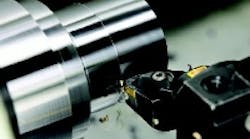A gold TiN coating on GC4225 flank surfaces provides users an accurate indication of edge wear.
For most shops, ISO P25 is the most difficult metal to cut. Components, operations, materials and machining conditions vary widely in this general turning classification, which can include operations from roughing to finishing of parts that are out-of-round or near-netshaped, cast or forged, unalloyed or high-alloyed materials and with hardnesses ranging from 150 to 350 Brinell.
With so many variables affecting cutting tool insert performance, finding one cutting tool grade to handle all the demands of P25 often is impossible. So shops typically switch between different insert grades to cover their own P25 applications, relying on past experience to determine which grade works best for a particular job. Now, Sandvik Coromant (www.sandvik.com) has developed an insert grade that the company says "does it all" for P25 applications and can be used effectively on applications for P20 and P30 grades of steel.
Sandvik Coromant says its GC4225 insert grade improves on its previous P25 grades by combining the latest technologies in carbide substrate and coating design. The insert's carbide substrate contains a gradient zone devoid of cubic carbides. Instead, the zone incorporates a tungsten carbide and cobalt binder that makes the insert fracture resistant. However, the insert's cutting edge has a high concentration of cubic carbides that provides the hardness necessary to resist the plastic deformation caused by the extreme temperatures generated in P25 cutting zones.
Notably, Sandvik Coromant says it has made a technological leap in the GC4225's coating and in its post treatment. The medium-temperature CVD coating combines TiCN, Al2O3 and TiN. Sandvik Coromant says the TiCN component prevents flank wear and, importantly, serves as the "glue" that adheres the Al2O3 component to the carbide substrate. This is critical because if a coating does not stick to an insert's carbide substrate, the substrate is exposed to the cutting zone causing premature failure.
Sandvik Coromant applies Al2O3, a ceramic coating, over the layer of TiCN to form a heat barrier between chips and the carbide substrate that prevents crater wear and plastic deformation, the two most prevalent causes of insert failure in steel turning. The company then puts a layer of TiN over the Al2O3 for wear identification.
After the coating process, Sandvik Coromant wet blasts the inserts. The wet blasting removes TiN layers from rake faces, exposes the Al2O3 on the rake faces and polishes those faces while preserving the TiN layer on flank sides.
Sandvik Coromant says the result is an ultrasmooth coating that retards edge build-up and crater wear, and maintains its integrity for long periods of time. Simultaneously, the gold-colored TiN coating remains on flank surfaces and helps to indicate insert-edge wear.
"When using black-colored inserts," says Bill Tisdall, product specialist at Sandvik Coromant, "operators often are unsure as to which insert edges are worn, so they usually change the inserts to be on the safe side, even though there may still be some usable edges."
While turning P25 steel, several types of wear can interact over the life of an insert, and can cause it to fail. The types of wear include flank wear, edge build-up, plastic deformation of cutting edges and cratering.
The ideal wear pattern for any insert, says Tisdall, is controlled flank wear, which results in predictable tool life of cutting edges. He says the GC4225 grade keeps unwanted types of wear from developing rapidly, and in some instances, from developing at all.









